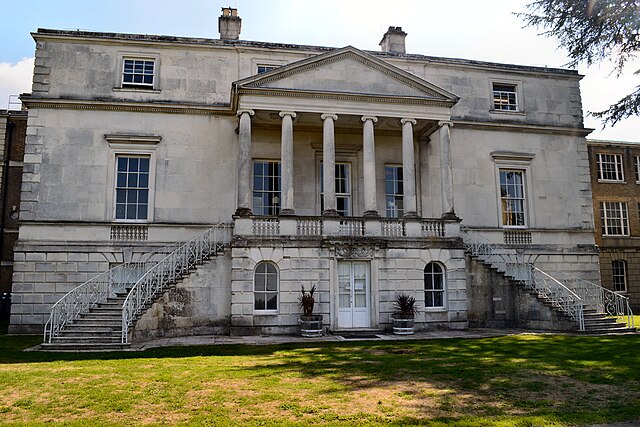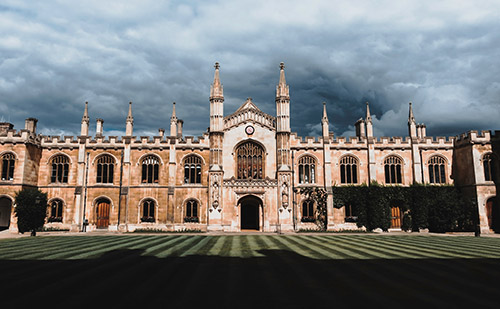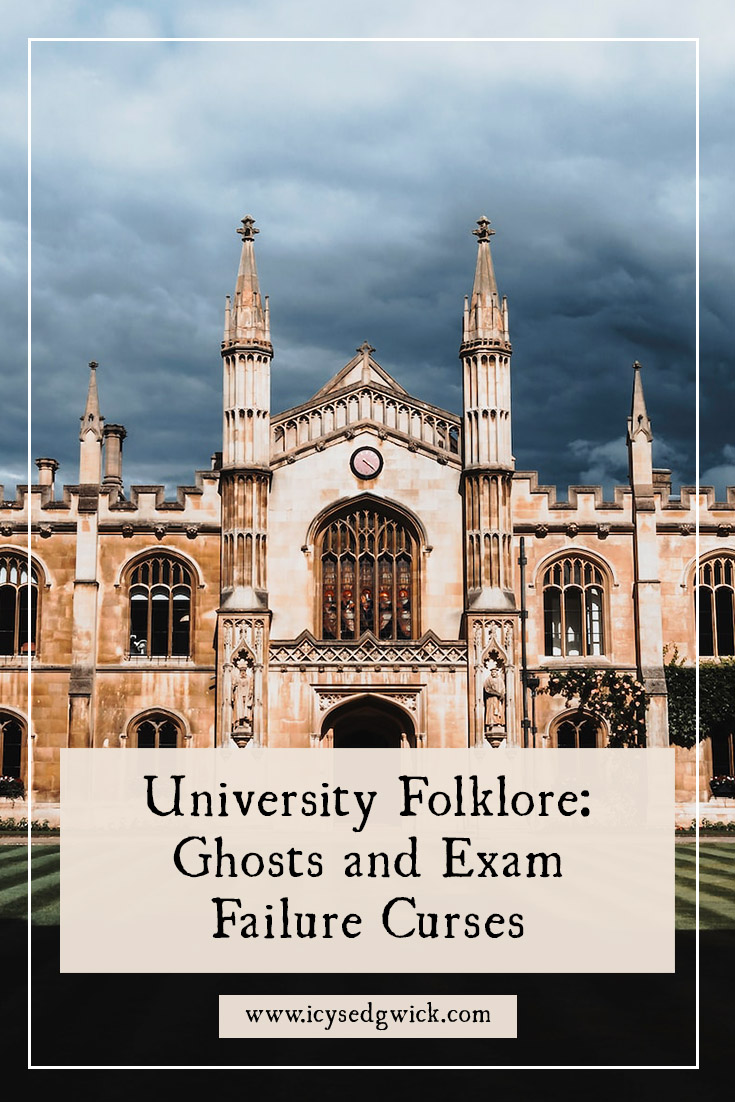In a lot of ways, it’s hardly surprising there is a lot of university folklore. People are away from home, often for the first time, in a strange environment with a lot of new places. They’re also often in old buildings where who only knows what has happened in the past.
So it’s easy for unusual stories to emerge.
For example, Karen told me about a “red room” on the Michigan State University campus “that had been the site of nefarious doings and was locked down to keep out looky-loos”. The stone lions outside McMicken Hall at the University of Cincinnati apparently growl at night. Some think they only do so if a cheater or a virgin passes them (Pancheva 2023).
But ghosts certainly make up a large proportion of the stories about universities, especially in the UK. So let’s look at some university folklore, including myths about failing your exams!
As with the school folklore post, I’ve included examples of folklore from primary sources. I asked if anyone had any stories for their university on social media, and some of the answers are here. Due to the relative lack, compared to schools, I’ve supplemented the stories with those in secondary sources.
Let’s dig into it!
Ghosts
I am aware that last October, the Knowledge Academy published ‘research’ naming the top 10 supposedly most haunted universities in the UK (Williams 2022). I’m deliberately disregarding it because their methodology was flawed. The criteria were based on how many cemeteries were nearby, or how many listed buildings were within a given radius. The closest they got to actual ghost stories was how many paranormal reports occurred within two miles of the university… which means they’ve included ghost stories that have nothing to do with the universities themselves.
So I’ve stuck to ghost stories about the university buildings since the focus of this post is folklore associated with the institution…which is largely comprised of the physical space.
And if you’re hoping for a discussion of the now-infamous Room 6-11 in Alanbrooke Hall at Queens University in Belfast, I’m sorry to disappoint you. The Uncanny Podcast has done a far better job of exploring the case and I highly recommend you check out their episodes to learn more about it.
Former Residents?
Graham told me about the old main building of the University of Wales at the Caerleon campus. Apparently, a maid fell over a staircase rail from the top floor. Her ghost continued to roam the building. As Graham explained, “You could actually see where a higher section of rail had been welded onto the lower (original?) metal”.
The campus closed in July 2016, so who knows what she’s doing now.
Meanwhile, Mike told me about Lincoln College Library in Oxford. All Saints’ Church on Turl Street closed in 1971 and reopened in 1976 as Lincoln College Library.
They removed the bodies in the crypt to make way for a basement library. As Mike told me, “For some months afterwards books in the area would be mysteriously moved and left on the floor overnight when the building was locked.” This one sounds like activity eventually ceased but if you know it hasn’t, let me know!

Shelleyesque, [CC BY-SA 4.0], via Wikimedia Commons
Finally, Aaron at the Appalachian Folklore Podcast told me a story from his time at Kent State University in Kent, Ohio. One night, his then-girlfriend woke up to see a “sopping wet woman standing by her bedside”. She figured it must have been the young woman who “drowned in the basement of her dorm building because a pipe burst while she was down there doing laundry”. She wasn’t the only one to have seen her, since her roommate and friend had similar experiences.
This all happened in Koonce Hall, which Aaron believed was named after the girl who died. Turns out the building is the only hall at the university named after a student – named for Judith E. Koonce and dedicated in 1968 (Kent State University 2023). Yet Judith didn’t die in the basement. She graduated in 1957 with a BSc in Education, and in 1958, she was a summer camp counsellor. A child fell into the Little Miami River and while Judith jumped in to mount a rescue, the powerful current overwhelmed her. The university renamed the building in honour of Judith’s bravery.
The University Dead House
Farley Hall at the University of Mississippi stands on the site of the old dead house, demolished in 1958. This previous building acted as a morgue to house war dead before burial at the Civil War Cemetery across the campus.

Christina Steube notes local anecdotes in which people claim to encounter ghostly presences in the area. No one knows if they’re Civil War victims or long dead students (2014).
Roehampton University
I did my MA at the University of Roehampton, and there were rumours of ghosts in Digby Stuart College. It’s the largest building on the main campus, and the Society of the Sacred Heart Sisters founded the college in 1874 to train women as teachers. In 2004-5, an upstairs corridor near the film lecturers’ offices had a distinctly eerie atmosphere. A lecturer once told me about hearing ghostly piano music late at night in the building. I doubt it’s related, but 119 bodies are apparently buried on the main campus (Neville 2018).
As well as Digby Stuart College, Roehampton also has three other colleges: Froebel, Southlands, and Whitelands. Whitelands is situated further down Roehampton Lane, beyond Danebury Avenue. In 1979, historian Joan P. Alcock wrote an account of the weird unexplained activity in Parkstead House, the main building at Whitelands.

In the early 1960s, workmen refused to work in parts of the building during alterations after dark. A student heard footsteps pass by him and along a corridor, which would be fine if access to the corridor hadn’t been blocked by a partition. Lecturers reported feeling unseen figures brush by them in the corridors. Another entered his classroom to see a berobed figure get up and move across the room (Neville 2018).
One of the domestic staff laid out coffee in Room 1 early one morning and left the room. When she came back, the tables had been overturned, spreading piles of magazines across the floor. It seems Room 1 and the Science laboratory were popular areas for activity! Alcock brought a visitor to the college, who then asked what happened in a top-floor room of the main building due to its atmosphere. Most telling, a caretaker reported that his dog flat-out refused to enter certain parts of the building (Neville 2018).
All my lectures took place in Southlands College…but you just know I now wish I’d wandered down to Whitelands for a look!
Cambridge University
Even top universities aren’t spared from supernatural shenanigans. Cambridge University boasts a few ghosts among its legends.
Both staff and students at Christ’s College report disembodied voices and footsteps, along with cold spots (Wilde 2022). A male ghost apparently circles a tree near the swimming pool at midnight on the full moon, believed to be Christopher Round. According to legend, Round began an affair with Mary Clifford, the lover of Phillip Collier, one of Round’s friends. One night, Round and Collier got steaming drunk, and Collier fell into the swimming pool. Round left him to drown, keen to secure Clifford for himself. Once sober, his actions haunted him for the rest of his life.
Meanwhile, Corpus Christi College’s most famous ghost is Dr Henry Butts. He was the college physician during the 17th century and he looked after the sick during a plague outbreak in the 1630s. Many credited his actions with keeping the death toll lower than it might have otherwise been. Unfortunately, Butts also suffered from depression and he took his life in 1632 (Wilde 2022).

Students attempted to exorcise Butts in 1904 in an attempt to free him, but people still report seeing him now (Wilde 2022).
Some also think the bodiless ghost of Oliver Cromwell patrols the grounds at Sidney Sussex College. His head allegedly rests here, and people think he’s looking for his body. Meanwhile, some report seeing the headless ghost of Charles I at Christ Church College (Pancheva 2023).
Failing Exams
Our final category relates to failed exams, or the fear of failing them—quite an understandable worry while you’re at university.
Heather told me a legend of an exam curse from the University Of Birmingham. Apparently, “if you pass through the arches of the clock tower in the middle of the main campus at midnight”, you’ll fail your exams.
Yet Royal Holloway, University of London has a long-running urban legend associated with failing exams. Sir Edwin Landseer’s painting, ‘Man Proposes, God Disposes’, hangs at the university. It depicts two polar bears tearing at the remains of a ship and its passengers. Landseer took inspiration from the disappearance of Sir John Franklin in 1845 while trying to chart the Northwest Passage.

As the myth runs, anyone who sits in front of it during an exam will fail. It’s difficult to pinpoint the start of the myth, but the painting has been associated with exams since they began there in the 1920s (Heyden 2014). By the 1970s, students so feared the painting that one student refused to be seated beside it in an exam. The registrar found the biggest thing available to cover the painting in order to get the exam underway. A huge Union flag saved the day, and covers the painting during exams even now (Heyden 2014).
The myth has changed slightly since the university started covering the painting. In one version, a student lost their mind and killed themselves right there in the exam hall after looking directly into one of the bears’ eyes. Reports conflict as to who the student was, or how they actually did it, because it never happened. Yet this myth seems to have staying power, so let’s see how it evolves over time.
Not all Urban Legends Are Malevolent
Marissa told a particularly joking urban legend from Vassar College in Poughkeepsie, NY. As the legend ran, “unemployed English majors (or some other “useless” humanities degree) would be given the choice to come back to campus and be reincarnated as squirrels after 5 years.” As she noted, the campus had a lot of squirrels!
I think this story helps to illustrate the motivation behind some of the folklore. Some of the stories relate to features of the campus, whether that’s statues, squirrels, or paintings. People might see them often, but the folklore becomes associated with them over time. The Royal Holloway ‘cursed painting’ myth is a great example of an urban legend in action, evolving to incorporate new elements.
Though the ghosts may serve a slightly different purpose. Dan told me about SUNY Cortland, one of the most haunted universities in New York state. In May 2022, the Introduction to Public History class revealed the results of a research project into the stories of hauntings on campus.
The students dug through the archives and discovered that none of the incidents behind the sightings were linked to factual records. But many of them popped up in the 1980s, which was the same time that the counselling centre started offering emotional support. The class found “the campus community responded to all these reports of supernatural visions by assisting any students who might be struggling with mental health issues or as survivors of sexual assault or violence in a relationship” (SUNY Cortland 2022). The students discovered how the ghost stories even went on to help the university more aware of issues on campus.
Perhaps the other ghost stories perform a similarly therapeutic function. They create a space in which students can share warnings and concerns without directly expressing them.
And, of course, sometimes students just like to scare each other.
What university folklore do you know from your town? Let me know below!
References
Kent State University (2023), ‘Koonce Hall Remembers Judy Koonce’, Kent State University, https://www.kent.edu/housing/koonce-hall-remembers-judy-koonce.
Magazine Monitor (2014), ‘The painting reputed to make students fail exams’, BBC News, https://www.bbc.co.uk/news/blogs-magazine-monitor-29175003.amp.
Neville, Iso (2018), ‘Halloween at Roehampton’, University of Roehampton, London, https://blog.roehampton.ac.uk/2018/10/31/halloween-at-roehampton/.
Pancheva, Vyara (2023), ‘5 creepy university urban legends’, Top Universities, https://www.topuniversities.com/blog/5-creepy-university-urban-legends.
Steube, Christina (2014), ‘Haunted History: Some older areas of campus have a spooky past’, Ole Miss, https://news.olemiss.edu/haunted-history/.
SUNY Cortland (2022), ‘History class explored real-life roots of ghostly claims’, SUNY Cortland, https://www2.cortland.edu/news/detail.dot?id=e284f846-28a8-4827-96fd-b4b17e6f1d22.
Wilde, Gabrielle (2022), ‘Cambridge University’s haunted colleges home to spooky scholars’, Cambridge Live, https://www.cambridge-news.co.uk/news/cambridge-news/cambridge-universitys-haunted-colleges-home-23498614.
Williams, Tracey (2022), ‘The Most Haunted Universities in the UK’, The Knowledge Academy, https://www.theknowledgeacademy.com/blog/the-most-haunted-universities-in-the-uk/.
Nutty about folklore and want more?
Add your email below and get these posts in your inbox every week.
You'll also get my 5-step guide to protecting your home using folklore!








Have your say!